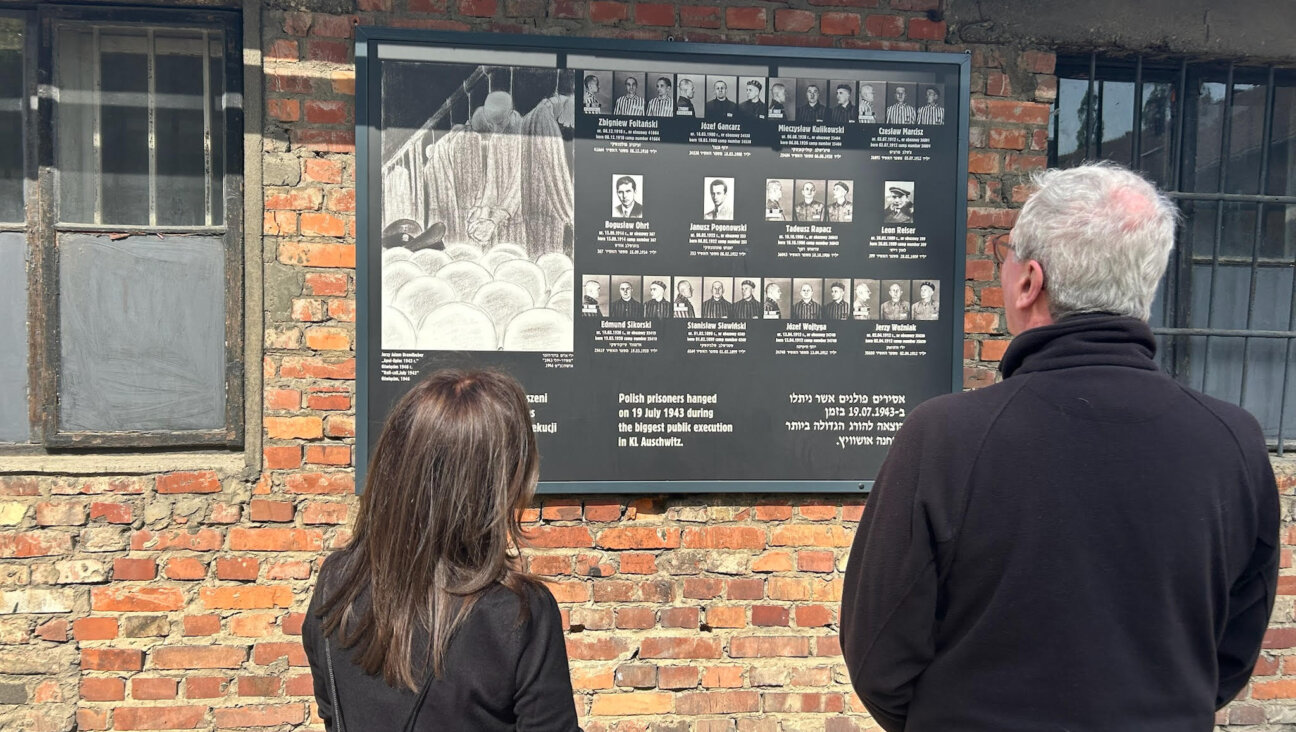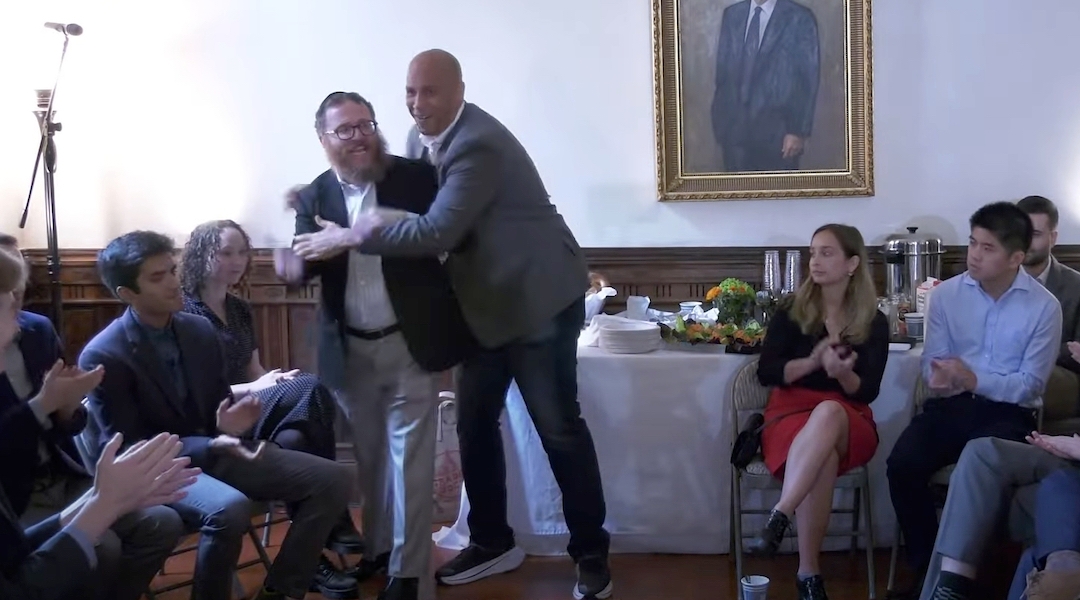A Modern-Day Miriam
The People of Israel’s first choreographer was Miriam who, according to the Torah, was acclaimed for her breathtaking victory dance over the Egyptian warriors. I, for one, cannot shake the image of Miriam leading the Israelite women, timbrel in hand, through the magical crossing of parted waves.
Our modern day Miriam is an unusual dancer in Israel named Yehudit Arnon. Arnon’s story of triumph and leadership through dance in Israel are the subject of an overdue biography, “Overseer of the Dance Estate, In a State of Rapture Over Dance: Details of the Life of Yehudit Arnon and the Kibbutz Dance Company,” by Avshalom Kave. Unfortunately, the book has only been released in Hebrew, so I’ve taken the opportunity of this column to highlight her story for our American readers.
Arnon was born 77 years ago in Komarno, Czechoslovakia, to a religious family that forbade her to dance. However, because Arnon suffered from scoliosis, she was sent to a physical therapist who taught her various kinds of exercises and encouraged her talents. Caught in the Nazi web, she and her family were pushed into a Czech ghetto and then deported to Auschwitz on June 11, 1944.
“I was sent to Birkenau,” she recounted in a recent interview with me. “With my shaved head and my tattooed number, I was one of 1,000 women in one barrack. We slept 10 to a slab, and if we wanted to turn over, all 10 of us had to move. Somehow we managed to live and even entertain each other. I was asked to show movement.” Before dark, she danced for this unlikely audience of women. By taking the very body the Nazis sought to exterminate as subhuman and dancing with it, Arnon transformed her encounter with hell.
In December 1944, the Nazis ordered Arnon to entertain them at a Christmas party. “I decided to say no to dancing for them,” remembered Arnon. “By then, we all wanted to die quickly, and I thought that I would be shot, which meant a swift death. Instead, for punishment I had to stand outside in the snow, barefoot. I could feel myself freezing. I decided that if I would survive, I would dedicate myself to dance.”
Arnon suffered through the freezing labor camps, a death march and another death-defying experience in front of a firing squad in May of 1945. She escaped and eventually reached a deportation camp in Avigliana, Italy, where she met her husband, Yedida. At the camp, she taught dance and he taught mathematics to 100 orphans detained there. Eventually, with the help of the Israeli underground, the Arnons smuggled all their students — who ranged in age from 6 to 16 — over borders and through forests, to Haifa’s safe harbors in 1948.
There, the couple became founding members of Kibbutz Ga’aton in the Galilee. Though she worked regularly in the kibbutz laundry, Arnon managed to travel to Haifa to study with influential Israeli dancers, including Gertrud Kraus and Yardena Cohen. She soon set out to convince her kibbutz of the importance of modern dance, at a time when most favored folk dance and egalitarian participation.
Her determination became legendary, and she argued that all the kibbutzim of the north should send her their talented dancers. In 1965, the kibbutz built her a proper dance studio, and she opened a dance center at Kibbutz Ga’aton for youngsters across the region. Her persistence and artistic vision extended to the international dance world when she convinced European and American choreographers and teachers to join with Israeli artists in her studio in the far north. In 1970 she founded the Kibbutz Dance Company (later known as the Kibbutz Contemporary Dance Company), which she directed for 25 years. Israel awarded her its highest acknowledgement in 1997, when she received the prestigious Israel Prize for her accomplishments.
Israel recognized Arnon this summer, too, with a book signing and a featured evening of dance at the Karmiel Dance Festival. This remarkable festival, in its 15th year, turns the entire Galilee town of Karmiel into a stage for dance — the tennis courts (minus their nets) were filled with Israeli folk dancers 24 hours a day; the town stadium featured folk dance troupes from all over Israel performing almost until dawn; an amphitheater, built down a mountainside, seated 50,000 for nightly extravaganzas of hundreds of dancers, and other major Israeli professional companies performed as members of lesser known ones mingled in the city squares, parks and gymnasiums throughout the four days and nights, bursting with energy and performances.
Thus it was that on the evening of July 9, seemingly the entire dance world of Israel was present at the Karmiel Cultural Arts Center Theater to honor Arnon. After signing copies of her biography for a long line of fans, Arnon took her place among the other audience members, who had come to watch some of Israel’s finest companies — including star performers from her own Kibbutz Contemporary Dance Company — celebrate the diminutive Arnon, small in stature but giant in spirit.
Jiri Kylian, the important Dutch choreographer, sent a videotaped message that almost perfectly summed up Arnon’s life and career: “We met many years ago in my office in the old studios of the Nederlands Dans Theater. I will always remember your slight figure and unassuming strength of conviction — to make a statement as a survivor who does not only want to live on, but wishes to hand something of great moment to the present generation, a message of dance, which represents freedom.”
The Forward is free to read, but it isn’t free to produce

I hope you appreciated this article. Before you go, I’d like to ask you to please support the Forward.
Now more than ever, American Jews need independent news they can trust, with reporting driven by truth, not ideology. We serve you, not any ideological agenda.
At a time when other newsrooms are closing or cutting back, the Forward has removed its paywall and invested additional resources to report on the ground from Israel and around the U.S. on the impact of the war, rising antisemitism and polarized discourse.
This is a great time to support independent Jewish journalism you rely on. Make a gift today!
— Rachel Fishman Feddersen, Publisher and CEO
Support our mission to tell the Jewish story fully and fairly.
Most Popular
- 1

Opinion The dangerous Nazi legend behind Trump’s ruthless grab for power
- 2

Opinion I first met Netanyahu in 1988. Here’s how he became the most destructive leader in Israel’s history.
- 3

Culture Did this Jewish literary titan have the right idea about Harry Potter and J.K. Rowling after all?
- 4

Opinion A Holocaust perpetrator was just celebrated on US soil. I think I know why no one objected.
In Case You Missed It
-

Opinion Trump’s heedless approach to an Iran deal could be a big problem for Israel
-

Fast Forward In NYC, Itamar Ben-Gvir says he’s changed — and wants ‘the Trump plan’ in Gaza
-

Opinion Itamar Ben-Gvir’s visit to a Jewish society at Yale exposed deep rifts between US Jews
-

Fast Forward On his first trip to Auschwitz, New Jersey governor urges vigilance against rising antisemitism
-
Shop the Forward Store
100% of profits support our journalism
Republish This Story
Please read before republishing
We’re happy to make this story available to republish for free, unless it originated with JTA, Haaretz or another publication (as indicated on the article) and as long as you follow our guidelines.
You must comply with the following:
- Credit the Forward
- Retain our pixel
- Preserve our canonical link in Google search
- Add a noindex tag in Google search
See our full guidelines for more information, and this guide for detail about canonical URLs.
To republish, copy the HTML by clicking on the yellow button to the right; it includes our tracking pixel, all paragraph styles and hyperlinks, the author byline and credit to the Forward. It does not include images; to avoid copyright violations, you must add them manually, following our guidelines. Please email us at [email protected], subject line “republish,” with any questions or to let us know what stories you’re picking up.















